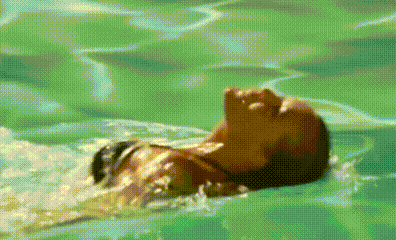
La Piscine
A brief analysis of ‘La Piscine’, directed by Jacques Duray and released in 1969.
SEA, SEX & SUN
Sophia Dax Kerr
6/9/20232 min read
It’s not even two seconds and we are plunged into the hazy state of midsummer in France; ‘Jean Paul’, incarnated by Alain Delon, lays by the poolside to start the film off, and is soon joined by his two-year-long partner Marianne, played by ‘Sissi’s’ Romy Schneider. Situated in Ramatuelle, a commune not far from St Tropez, we witness a young couple spend their shared hours in an isolated villa, one unlike the others with its mythological essence of cream pillars, the scatter of Greek statues, all encompassed by bucolic nature.
The ‘qu’est-ce qu’on fait?’...’ce que tu veux...’ dynamic is very much evoked. Both of them escaping their jobs in the outside world are jointly comforted by the pleasant, effortless rituals of lie-ins, swimming, smoking, soaking up the sun, cascading on their darkening bodies until nightfall, making love... What Deray has seemingly captured here is the stillness felt in summers. It’s that, as well as his marking illustration of the couple’s lustful relationship. The scenes become more and more sensual, with touch being the protagonists’ main forms of communication (for those who have watched, we must admit that they don’t talk very much). In that branch scene, for example; it’s almost as if the sun’s intensity of the day has successfully absorbed into their bodies, the skin now humming and radiating this built-up, sexual energy from the afterglow. See, they’re living in this simple suspension of time, their cycle interrupted only once that Red Maserati pulls through the driveway; inside, visitors from the outside. Harry (Maurice Ronet), an old friend of JP and former lover of Marianne, is warmly welcomed in the abode, accompanied by his 18-year-old daughter Penelope (Jane Birkin).
Tensions amount slowly; they have intruded on what seemed to have been the couple’s detoxing safety nest until cracks in the relationship become increasingly apparent, chiefly Marianne's temptations from her old flame and JP’s wondering eyes on the socially-awkward teenager willowing about in flimsy dresses. Duray manages to evoke these tensions quite cryptically; the competitive swim race between Harry and JP, the unwanted discussion of the latter's future prospects of marriage... An unspoken suffocation is felt, becoming so heavy it spirals into a drunken-fuelled incident. At this point, JP can no longer tolerate Harry’s presence, who seems to be the talking shadow of his future self. For those who need reminding, when Harry accidentally falls into the pool, JP playfully obstructs him from getting back on the land. After several attempts of getting back up, Alain continuously pushes him back down, eventually exceeding the limit by murdering him, succumbing to his own darker thoughts of extinguishing what he represents. Despite Harry’s outward depiction as a spontaneous, charming bon-vivant, what has driven JP to commit such a crime in an Eden-like paradise is his own destructive contemplations; through his eyes, what he sees lurking behind the veil of his old friend is an abyss; a lonely divorcee left with a child he uses by somewhat treating her like bait, masking his inner solitude through lavish lifestyle. In other words, a walking midlife crisis.
After his death, the dream has plummeted; the casual nudity shared by the characters in prior scenes is quickly replaced with fully dressed attire as if preparing to go back into the ‘real world’. An end of the season or the end of a façade? The character of Alain Delon must now face the reality of his failed writing career and adapt to his recent job in advertising, a thought he has been dimming away all this time through simple pleasures and procrastination; “Il y a des jours où j’en ai marre... marre, marre. J’ai envie de me tirer”.
xoxo, Sophia
